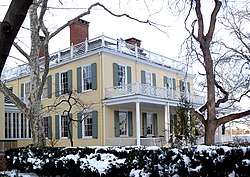Carl Schurz Park


Carl Schurz Park
Description

Carl Schurz Park overlooks the waters of
The park contains winding, shady paths, green lawns, waterfront views, basketball courts, a large playground for children, and two dog runs: one designated for larger dogs and one for smaller dogs.[1] The park is maintained by Carl Schurz Park Conservancy, the oldest park conservancy in New York City, in partnership with the New York City Department of Parks and Recreation.
History
The bluff overlooking a curve in the
The section of the park lying south of 86th Street (set aside as "East River Park" in 1876), where John Jacob Astor once had a villa, was used as a picnic ground when the northern section was acquired by the City of New York in 1891.[note 3] The easternmost block of 86th Street was acquired subsequently, and the street de-mapped. A new landscape design by Calvert Vaux and Samuel Parsons was completed in 1902, several years after Vaux's death.
East River Park was renamed Carl Schurz Park in 1911.[3] The park was reconstructed in 1935 by Robert Moses, due to the creation of the FDR Drive,[4] with revised landscaping by Maud Sargent. The park's restoration from a neglected state in the early 1970s was due to the energies of a neighborhood group, the not-for-profit Carl Schurz Park Conservancy (incorporated 1974), formed originally to clean up the park's single playground.[5]
Carl Schurz Park served as the location for the climactic fight scene in Spike Lee's 2002 film 25th Hour, starring Edward Norton and Philip Seymour Hoffman.
Notes
- ^ The account of the site's history is from The WPA Guide to New York City, (1939, 1982; p. 250f).
- ^ This was one of a series of unconnected small batteries along the East River.
- ^ So called in Frank Bergen Kelley and Edward Hagaman Hall Historical Guide to the City of New York (City History Club of New York) 190, p.135, where Astor's villa is mentioned.
References
- ^ "Carl Schurz Park Dog-friendly Areas". www.nycgovparks.org.
- ^ New York State Military Museum
- ISSN 0362-4331. Retrieved January 13, 2024.
- Caro, Robert A. (1975), The Power Broker, p. 373.
- ^ Carl Schurz Park Association: history Archived July 29, 2012, at archive.today
- The WPA Guide to New York City, (1939, 1982; p. 250f)
- Frank Bergen Kelley and Edward Hagaman Hall Historical Guide to the City of New York (City History Club of New York) 190, p. 135
- http://www.carlschurzparknyc.org/the-history-of-the-conservancy
